Benchmarking is more than just comparing numbers—it’s about using effective benchmarking strategies and data-driven insights to improve institutional performance and decision-making. But how can institutions implement effective benchmarking strategies that truly make an impact?
1. Define Your Goals and Key Performance Indicators (KPIs)
Effective benchmarking starts with clarity. Institutions should identify KPIs that align with their strategic goals, ensuring that data collection is purposeful and actionable. Without clear objectives, benchmarking efforts can become unfocused and ineffective.
When selecting KPIs, institutions should consider both quantitative and qualitative metrics, such as student retention rates, graduation rates, faculty engagement, and student satisfaction surveys. These metrics help institutions identify trends and make evidence-based improvements in key areas.
2. Understand the Educational Landscape
Context matters. To benchmark effectively, institutions need to compare themselves against relevant peers, considering factors like institution size, student demographics, and program offerings.
Understanding the broader educational landscape also means staying informed about emerging trends in online and distance education, accreditation requirements, and student success initiatives. By analyzing both internal and external data, institutions can better position themselves for long-term success.
3. Leverage Expert Insights for Interpretation
Data is only valuable if it’s understood and applied correctly. IDEBP works closely with institutions to provide data interpretation and tailored strategies that address unique challenges and opportunities.
Rather than viewing benchmarking data in isolation, institutions should use it to identify patterns, strengths, and areas for improvement. Expert guidance can help ensure that benchmarking insights lead to practical and impactful decision-making.
4. Implement and Adapt
Benchmarking should be a continuous process, not a one-time exercise. Institutions must regularly assess their data, adjust their strategies, and evolve with new trends to stay competitive.
A well-structured benchmarking system allows institutions to track progress over time, set realistic goals, and refine strategies based on new insights. Institutions that incorporate benchmarking into their long-term strategic planning are better equipped to adapt to changes in the higher education landscape.
5. Turn Insights Into Action
The true power of effective benchmarking strategies lies in how they are used. Institutions that act on benchmarking data can optimize resources, refine policies, and drive better student outcomes.
Benchmarking should lead to real improvements, whether it’s enhancing student support services, improving faculty development programs, or adjusting course offerings to better meet student needs. The institutions that succeed in benchmarking are those that translate data into actionable change.
Start Benchmarking with IDEBP
Our approach goes beyond data—we provide strategic insights, institutional comparisons, and expert guidance to help you make informed decisions.
Whether you’re looking to improve student retention, streamline administrative processes, or enhance faculty engagement, effective benchmarking strategies can help you achieve your goals
Learn more about how benchmarking can shape your institution’s future.

